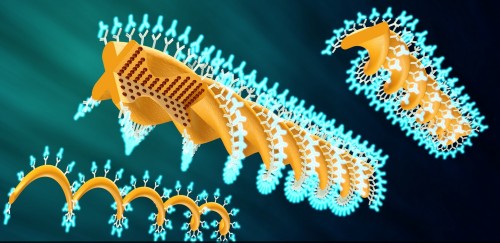Researchers have succeeded in developing more improved structures consisting of tiny magnetic actuation mechanisms, thanks to innovative materials combined with microscopic XNUMXD printing technology

Scientists are conducting research on micrometer operating mechanisms that could, one day, enable the delivery of drugs or sensing molecules to specific targets within the body. Researchers from the Zurich Institute of Technology in Germany have now advanced the development of such micro-devices by improving a crucial step: new production technology and innovative materials make it possible to produce tiny operating mechanisms in any shape while adapting them to future applications as required.
The elongated operating arrays, capable of moving in liquids, have a helical structure and are also magnetic. They are activated by an external rotating protective field; They are organized along the magnetic field lines and rotate on their longitudinal axis. Thanks to their helical shape, they are able to move forward through liquids.
When using conventional manufacturing methods, the magnetic properties of these micro-objects depend on the shape of the devices themselves. This limitation made it difficult for the researchers to develop actuation mechanisms with precise control and stable movement, as one of the researchers explains: "In the past, such elements would oscillate while moving forward, and they were less efficient because their magnetic properties were not ideal. Now we have succeeded in developing a new material and production method that allow us to adjust the magnetic properties independently of the structure of the bone." The researchers utilized a light-sensitive biocompatible epoxy resin, which they incorporated into magnetic nanoparticles. In the first step, they exposed a thin layer of this material to a magnetic field. This magnetic field induces magnetism on the nanoparticles and causes them to rearrange themselves in an array of parallel lines. The directionality of these lines determines the magnetic properties of the material. In the next step, the scientists caused the structures to undergo polymerization with the help of light radiation.
This method is similar to a microscopic XNUMXD printer: a laser beam is moved in a computer-controlled and XNUMXD manner within the epoxy resin, thereby causing the resin to be locally enhanced. Areas that have not undergone this bleaching are then removed by washing with a solvent.
The method allowed the researchers to produce helical structures with a length of 60 micrometers and a diameter of 9 micrometers, while obtaining magnetism perpendicular to the longitudinal axis. Other methods are unable to produce structures with such magnetic directionality. The resulting arrays can be precisely controlled and move four times faster than previous structures, and in addition their movement is stable and they do not oscillate.
Previous micro-actuators were helical in shape, however, thanks to the new microscopic 4D manufacturing technology, researchers are able to build different shapes. As part of the research, the scientists were able to produce structures similar to spirals, coiled strips and double coiled wires. Experiments conducted by the researchers showed that the new buildings move at a speed similar to previous buildings, but they differ in that their surface area is XNUMX times larger than the previous ones. "This feature makes our new structures more interesting in terms of possible applications," says one of the researchers.
If researchers want to use these structures to deliver drugs or chemical detectors into specific targets within the body, they will need to be coated with the appropriate molecules; And the larger the surface area, the more it will be possible to carry a larger amount for transfer. The researchers demonstrated that it is indeed possible to do so, by coating the structures in the form of spiral motors with antibodies, which are important and interesting biomedical substances. "However, our research is important not only thanks to the propulsion of micro-robots," notes the lead researcher. "Our innovative technology could also be used for the production of other micro-objects with defined and controlled magnetic properties."

One response
The Zurich Institute of Technology in "Germany"?